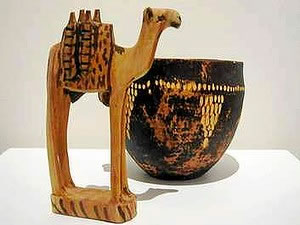This didactic exhibition is the brainchild of Aden Ibrahim who heads the Somali Cultural Association (SCA). Since 1995, the SCA has aimed to foster awareness of the Somali way of life while also sustaining cultural traditions among the Somali diaspora, which now numbers more than 17,000 in Victoria.
Central to exhibits about the daily life of a nomadic family group, one that owns a couple of camels and goats, say, is the hangool, a pronged stave made from a sapling, usually about a metre and half long, here seen in a shortened form, along with a milk bowl, a pestle and mortar, camel bell, and a neck rest, all carved from single pieces of wood.
The last of these has symbolic value. It is said that the neck rest represents vigilance, as it affords the user respite, rather than promoting deep sleep. Certainly, this show is about survival.
AdvertisementInferior contemporary versions of traditional artefacts are shown alongside fine historical exhibits, including a century-old basket. This is jarring to the gallery-goer interested in the significance of materials.
Particularly problematic are the oil paintings commissioned from either Jama Ganei, who lives in Somalia, or Ahmed Barre, a resident of Melbourne. A single painting by Aden Mursal was done in a refugee camp in Djibouti, with materials sourced in Dubai under Ibrahim's auspices.
All of these canvases were executed to Ibrahim's specific instructions regarding content. Their commonality of palette and design, their anecdotal role - and their aesthetic shortcomings - are the result of this collaborative process.
Given the right context, these images might have been part of a narrative frieze of some power and poignancy. Regrettably, as easel paintings exhibited in a municipal temple of culture, they mostly look quaint.
Although the country's occupation by Italy and Britain coincided roughly with the development of Modernism in Western culture, there is no tradition of studio painting in Somalia for these painters to draw on.
But consider, for example, Barre's head and torso of a camel boy whose bachelor status is evident in his halo of stiffened hair, and who holds some of the implements mentioned above.
 Somali artefacts, part of the Somali Down Under exhibition. |
Painstaking brushwork, an understanding of principles of light and shade in creating volume, and attention to graphic details cannot disguise the absence of artistic vision, but occasionally, as with this image, the result is delightful.
The boy is a smile in the landscape. He stands in the savannah, his arms akimbo, like a road sign at a crossroad. He is an angular lady-boy with a limp wrist who has strayed from an Egyptian tomb painting. No, really.
Paradoxically, the ''authentic inauthenticity'' of these images - for that is what Ibrahim's project of fostering such painting results in - is what makes the show profound. By default, their formal dislocation signifies the refugee experience.
There is a bonus. A photograph from 1960, in the introductory section, has generated a contemporary legend that does not have epic status, but has entered popular culture. (For an example of an ancestral tale from this land of epic poetry see Kulmiye, Last of the Lion Hunters, self-published by Ibrahim and illustrator Margaret Gambold, in 2010.)
Aden H. Kulmiye's gorgeous monochrome portrait is of Asli Warsame. Titled The Bride, it was taken on July 1, 1960, the date of Somali independence - Warsame having vowed to marry only when Somalia was free.
Recent history has not been kind to Somalia, and perhaps we can read uncertainty in the young woman's eyes - and even, perhaps, something of her soulfulness in similar dark eyes met with on Melbourne streets.
No comments:
Post a Comment